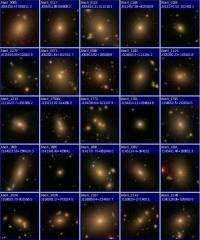IDGal
Study on the Galaxy Evolution Through the Interplay Between Stars and Interstellar Medium (Radiative Transfer Study of Ionized, Dusty Galaxies) |
| PI | Kwang-Il Seon |
| Co-I | Jong-Ho Shinn, Young-Soo Jo |
| Description | Study the interplay between the ISM (Interstellar Medium), IGM (Intergalactic Medium), and stars through radiative transfer models. |
SULF
KMTNet Southern Sky Ultra-Faint Dwarf Satellite Galaxy Survey |
| PI | Eon-Chang Sung |
| Co-I | Jaemann Kyeong, Seok-Joo Joo, Soung-Chul Yang, Helmut Jerjen (ANU), Dongwon Kim (ANU), Soo-Chang Rey (CNU), Youngdae Lee (CNU) |
| Description | KMTNet Southern Sky Ultra-Faint Dwarf Satellite Galaxy Survey (SULF) is a deep survey program to search for the ultra-faint dwarf satellite galaxies in the southern hemisphere. While hundreds of dwarf galaxies are predicted to be randomly distributed around our Milky Way galaxy by modern cosmological theory and galaxy formation simulations, only dozens of companion satellites are discovered thus far, even statistically aligned in a plane. This current discrepancy between the theory and observation may be at least partially caused by incompleteness in the census of dwarf satellites, and therefore, a substantial improvement in the cosmological models can only be achieved if the exact number and properties of those galaxies are provided. In order to detect those faint objects, we survey ~4,000 square degree of sky using the KMTNet 1.6-m telescope with wide field of view (2°x 2°) at CTIO. 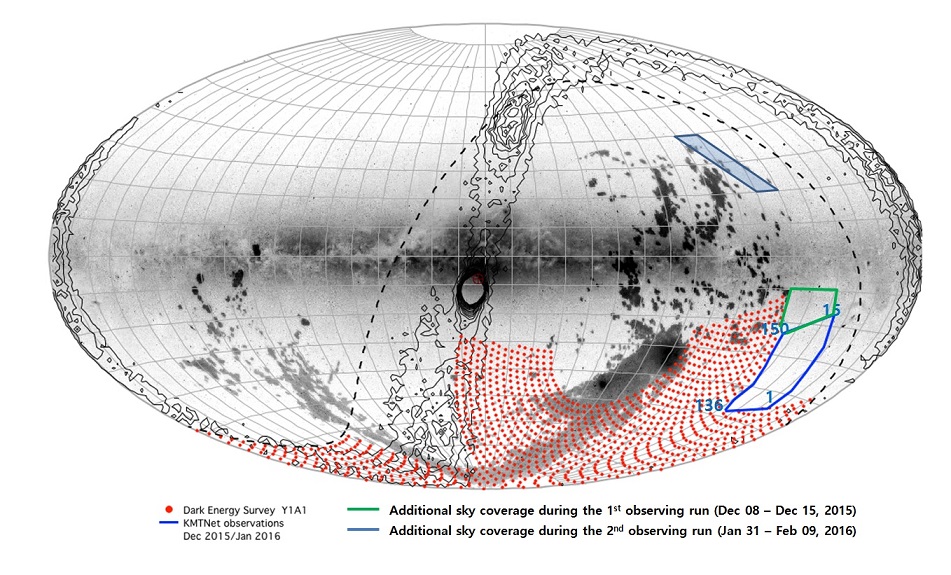 |
KSP
KMTNet Supernova Project |
| PI | Dae-Sik Moon (Univ. of Toronto) |
| Co-I | Sang Chul Kim, Jae-Joon Lee, Hong Soo Park, Avishay Gal-Yam (Weizmann Institute of Science), S. Bradley Cenko (Goddard Space Flight Center), D. Andrew Howell (LCOGT), Santiago Gonzalez-Gaitan (Universidad de Chile), Bon-Chul Koo (SNU), Mario Hamuy (Universidad de Chile), Stuart Ryder (AAO), Giuliano Pignata (Universidad Andres Bello), Moo-Young Chun, and Others |
| Description | 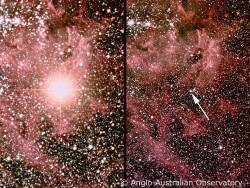 KMTNet Supernova Project (KSP) is to observe supernovae (SNe) in the southern sky using three 1.6m telescopes with wide-field (2 deg x 2 deg) camera located at three sites of Chile, Australia, and South Africa. KMTNet camera has 18K x 18K pixel size and each pixel corresponds to 0.40 arcsec in the sky. The early and long-term photometric evolution of SNe are to be studied taking the advantage of 24-hour coverage of the three telescopes. Observing various external galaxies using BVI filters, researches can be made on young SNe, explosion mechanism, progenitor stars, peculiar SNe and SN classification as well as many kinds of variable objects, galaxies and active galactic nuclei. The most excited thing might be discovery of something totally unexpected! KMTNet Supernova Project (KSP) is to observe supernovae (SNe) in the southern sky using three 1.6m telescopes with wide-field (2 deg x 2 deg) camera located at three sites of Chile, Australia, and South Africa. KMTNet camera has 18K x 18K pixel size and each pixel corresponds to 0.40 arcsec in the sky. The early and long-term photometric evolution of SNe are to be studied taking the advantage of 24-hour coverage of the three telescopes. Observing various external galaxies using BVI filters, researches can be made on young SNe, explosion mechanism, progenitor stars, peculiar SNe and SN classification as well as many kinds of variable objects, galaxies and active galactic nuclei. The most excited thing might be discovery of something totally unexpected! |
Dwarf
Evolution of Dwarf Galaxies in Different Environments |
| PI | Sanjaya Paudel |
| Co-I | Chang Hee Ree, Minjin Kim, Michael Hilker (ESO), Pierre-Alain Duc (CEA Saclay), Thorsten Lisker (Heidelberg) |
| Description | 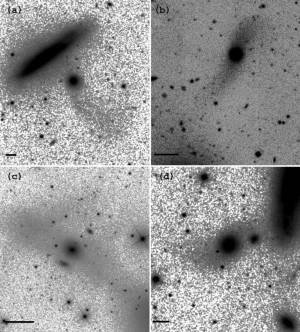 In this project we plan to perform systematic study of dwarf galaxies with tidal feature. First we present an extended catalog of dwarf galaxies with tidal feature that we have prepared from the Sloan Digital all Sky Survey (SDSS). Furthermore, we aim to perform detailed study of these galaxies with help of follow up observations using deep imaging, spectroscopy and radio data. Our main goals are: In this project we plan to perform systematic study of dwarf galaxies with tidal feature. First we present an extended catalog of dwarf galaxies with tidal feature that we have prepared from the Sloan Digital all Sky Survey (SDSS). Furthermore, we aim to perform detailed study of these galaxies with help of follow up observations using deep imaging, spectroscopy and radio data. Our main goals are:1) To understand the formation and evolution of early-type dwarf galaxies (dEs) in different environments such as cluster, group and the field, and to characterize the variation of structural and stellar population properties of dEs according to the environments where they reside. 2) To explore how the disruptive tidal forces shape the various structural and stellar population properties of galaxies and how likely that hierarchical cosmology could be the main driver of galaxy evolution in low mass scale. 3) To study the HI atomic gas structure around the merging dwarf galaxies which may offer indispensable information in constructing a detailed picture of a “BCD phase” being triggered by mergers between gas rich dwarf galaxies. |
| Publications | SDSS J085431.18+173730.5: The First Compact Elliptical Galaxy Hosting an Active Nucleus, Sanjaya Paudel, Michael Hilker, Chang Hee Ree, Minjin Kim (2016) ApJ, 820L, 19 A Case Study for a Tidal Interaction between Dwarf Galaxies in UGC 6741, Sanjaya Paudel, Pierre-Alain Duc, Chang Hee Ree (2015) AJ, 149, 114 Tidal Interaction as the Origin of Early-type Dwarf Galaxies in Group Environments, Sanjaya Paudel, Chang Hee Ree (2014) ApJ, 796L, 14 An isolated, compact early-type galaxy with a diffuse stellar component: merger origin?, Sanjaya Paudel, Thorsten Lisker, K. S. A. Hansson, Avon Huxor (2014) MNRAS, 443, 446 |
| Presentations | |
| News | AAS NOVA Highlights, An Active Black Hole in a Compact Dwarf (4 May 2016) |
MUNIC
Multispectral Narrow-band Imaging Campaign for Nearby Old Stellar Systems |
| PI | Chang Hee Ree |
| Co-I | Hyunjin Jeong, Sang-Il Han, Young-Wook Lee (Yonsei) |
| Description | 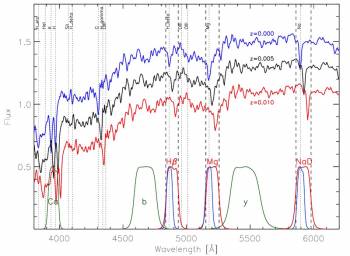 MUNIC is an imaging survey campaign to study the stellar population structure of nearby galaxies by mimicking large-aperture 2D integral field spectroscopy at several major optical lines with custom-designed narrowband filters. Our main focus is on the absorption line systems, such as elliptical galaxies, dwarf ellipticals, and local group dwarf spheroidal galaxies, which have been yet unexplored with narrowband filter imaging. The primary goal is, by mapping nearby galaxies with at least three major absorption lines (H-beta, Mg, and NaD), to measure the galaxy-wide internal dispersions of age and metallicity to characterise the history of star-formation and chemical enrichment of the present-day old stellar systems. MUNIC is an imaging survey campaign to study the stellar population structure of nearby galaxies by mimicking large-aperture 2D integral field spectroscopy at several major optical lines with custom-designed narrowband filters. Our main focus is on the absorption line systems, such as elliptical galaxies, dwarf ellipticals, and local group dwarf spheroidal galaxies, which have been yet unexplored with narrowband filter imaging. The primary goal is, by mapping nearby galaxies with at least three major absorption lines (H-beta, Mg, and NaD), to measure the galaxy-wide internal dispersions of age and metallicity to characterise the history of star-formation and chemical enrichment of the present-day old stellar systems. |
| Publications | Evidence for Enrichment by Supernovae in the Globular Cluster NGC 6273, Sang-Il Han, Dongwook Lee, Hyunju Seo, Young-Wook Lee (2015) ApJ, 813L, 43 |
| Presentations | “Multispectral Narrow-band Imaging Campaign for Nearby Old Stellar Systems”, Chang H. Ree, Hyunjin Jeong, Sang-Il Han, Young-Wook Lee, Michael Hilker, EWASS 2016, S3: MUSE first year science and beyond, Athens, 4-8 July, 2016 |
KNGS
KMTNet Nearby Galaxy Survey |
| PI | Minjin Kim |
| Co-I | Yun-Kyeong Sheen, Woowon Byun, Joon Hyeop Lee, Kwang-Il Seon, Hyunjin Jeong, Sang Chul Kim |
| Description | We will obtain deep and wide-field imaging of nearby galaxies using KMTNet telescope, in order to explore the origin of faint extended features in the outer regions of galaxies. |
ToMs
Tracing the Formation of Massive Galaxies |
| PI | Hyunjin Jeong |
| Co-I | Seok-Joo Joo, Suk Kim, Jaehyun Lee, Youngdae Lee |
| Description |  The main goal of ToMs (Tracing the Formation of Massive Galaxies) project is to understand the formation and evolution of massive early-type galaxies. The exact mass assembly history of early-type galaxies remains one of the most intense and controversial debates in modern astronomy. Recently a new paradigm has emerged for the formation of early-type galaxies, a two-phase formation scenario, which could be considered as mixture of monolithic collapse and hierarchical merging models: (1) The first phase occurs early in the universe (i.e. > 10 Gyrs ago) and forms the bulk of the stars through intense dissipation processes such as cold accretion or gas-rich major mergers with effective radii of ~ 1 kpc (i.e. in situ). (2) The second phase may continue to the current time and involves the accretion of stars formed in smaller galaxies (i.e. ex situ). These accreted stars are added at radii larger than the effective radius.To understand the detailed assembly history of massive early-type galaxies in different environments, we constructed a catalogue of massive early-type galaxies (Mr≤-21.5) in the redshift range 0.00<z<0.05 from the SDSS DR12 and measured the density of each galaxy by counting the number of companion galaxies within three-dimensional space. We will aim to reveal the formation and evolution of massive galaxies by comparing models (N-body/Semi-analytic prescriptions) to the galaxy data observed. The main goal of ToMs (Tracing the Formation of Massive Galaxies) project is to understand the formation and evolution of massive early-type galaxies. The exact mass assembly history of early-type galaxies remains one of the most intense and controversial debates in modern astronomy. Recently a new paradigm has emerged for the formation of early-type galaxies, a two-phase formation scenario, which could be considered as mixture of monolithic collapse and hierarchical merging models: (1) The first phase occurs early in the universe (i.e. > 10 Gyrs ago) and forms the bulk of the stars through intense dissipation processes such as cold accretion or gas-rich major mergers with effective radii of ~ 1 kpc (i.e. in situ). (2) The second phase may continue to the current time and involves the accretion of stars formed in smaller galaxies (i.e. ex situ). These accreted stars are added at radii larger than the effective radius.To understand the detailed assembly history of massive early-type galaxies in different environments, we constructed a catalogue of massive early-type galaxies (Mr≤-21.5) in the redshift range 0.00<z<0.05 from the SDSS DR12 and measured the density of each galaxy by counting the number of companion galaxies within three-dimensional space. We will aim to reveal the formation and evolution of massive galaxies by comparing models (N-body/Semi-analytic prescriptions) to the galaxy data observed. |
CLEVOR
CLuster EVOlution Research |
HIZ
Galaxy Formation and Evolution in High Redshift Universe |
| PI | Yujin Yang |
| Co-I | |
| Description |
Computation: simulations and big data analysis
Several group members focus on 1) computational simulations on galaxy formation and evolution, and 2) computational data analysis of big astronomical data, particularly, produced by survey observation of galaxies. In the first topic, we have used various simulation codes such as Gadget, FLASH, RAMSES, and Athena to conduct (M)HD simulations of galaxy formation and evolution. We are also developing new approaches in modeling galaxy formation. In the second topic, our research exploits new machine learning and data analytics methods and technology in applications of astronomy. We have used various machine learning methods to analyze big astronomical data.
Recent research highlights are:
AVENGERS
Along Various ENvironments, Galaxy Evolution ResearcherS |
| PI | Joon Hyeop Lee |
| Co-I | Hye-Ran Lee, Mina Pak |
| Consultant | Hyunjin Jeong, Soung-Chul Yang, Kwang-Il Seon, Yujin Yang, Rory Smith, Suk Kim |
| Description | 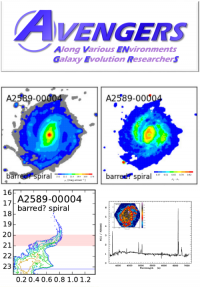 The observational and theoretical achievement in recent decades has led us very close to the completion of the big picture about galaxy formation and evolution. The statistical properties and behaviors of galaxies have been deeply understood, which are often summarized as the inside-out two-phase formation scenario, today. However, various details in such a big picture have not been perfectly unveiled yet. What are the exact manners in which environments influence galaxy evolution? How important are environmental effects on galaxy evolution compared to secular evolution? How are star formation quenching and morphological transformation related with each other and what are the roles of environments in them? The AVENGERS approach these issues mainly through spatially resolved investigation of galaxies in various environments, such as integral field spectroscopy (IFS) and photometric pixel analysis. An important purpose of this project is to assist the two PhD students (Hye-Ran and Mina) to obtain doctorates. The observational and theoretical achievement in recent decades has led us very close to the completion of the big picture about galaxy formation and evolution. The statistical properties and behaviors of galaxies have been deeply understood, which are often summarized as the inside-out two-phase formation scenario, today. However, various details in such a big picture have not been perfectly unveiled yet. What are the exact manners in which environments influence galaxy evolution? How important are environmental effects on galaxy evolution compared to secular evolution? How are star formation quenching and morphological transformation related with each other and what are the roles of environments in them? The AVENGERS approach these issues mainly through spatially resolved investigation of galaxies in various environments, such as integral field spectroscopy (IFS) and photometric pixel analysis. An important purpose of this project is to assist the two PhD students (Hye-Ran and Mina) to obtain doctorates. |
| Publications | Small-scale Dynamical Coherence Accompanied with Galaxy Conformity, Joon Hyeop Lee, Mina Pak, Hye-Ran Lee (2020) ApJ, 893, 154 Mysterious Coherence in Several-megaparsec Scales between Galaxy Rotation and Neighbor Motion, Joon Hyeop Lee, Mina Pak, Hyunmi Song, Hye-Ran Lee, Suk Kim, Hyunjin Jeong (2019) ApJ, 884, 104 : NewScientist, VICE.com Stellar Populations of Nine Passive Spiral Galaxies from the CALIFA Survey: Are They Progenitors of S0s?, Mina Pak, Joon Hyeop Lee, Hyunjin Jeong, Suk Kim, Rory Smith, Hye-Ran Lee (2019) ApJ, 880, 149 Galaxy Rotation Coherent with the Motions of Neighbors: Discovery of Observational Evidence, Joon Hyeop Lee, Mina Pak, Hye-Ran Lee, Hyunmi Song (2019) ApJ, 872, 78 : Calar Alto Observatory Press Release, 천문연 보도자료 Color Dispersion as an Indicator of Stellar Population Complexity: Insights from the Pixel Color–Magnitude Diagrams of 32 Bright Galaxies in Abell 1139 and Abell 2589, Joon Hyeop Lee, Mina Pak, Hye-Ran Lee, Sree Oh (2018) ApJ, 857, 102 pCMD Analysis of the BCGs in Dynamically Young and Old Clusters A1139 and A2589, Joon Hyeop Lee, Sree Oh, Hyunjin Jeong, et al. (2017) ApJ, 844, 81 |
